T bone vs Porterhouse: two steak varieties often compared and misunderstood. Both come from the short loin section of a steer, but what’s the real difference? Is one better than the other? The answer may surprise you. These two cuts of beef share many characteristics but also have some notable differences that affect taste and cooking.
Understanding their variations can help consumers make better-informed decisions when selecting the perfect steak for their meal. Knowing the difference between a T-bone vs. Porterhouse can elevate your steak game to the next level, whether it’s a backyard BBQ or a fine dining experience.
What is T Bone?
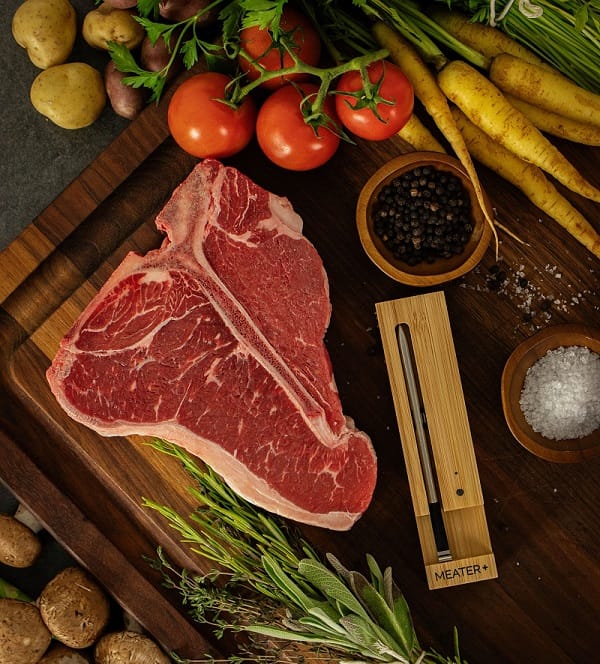
The T-bone steak is a beef cut from the cow’s short loin. This cut gets its name from the shape of the bone that runs through the center of the meat, forming a “T” shape. You have the tenderloin on one side of the bone, known for its buttery texture and mild flavor. On the other side, you have the strip steak, which is slightly firmer and has a meatier taste.
The T-bone steak typically weighs between 16-24 ounces and is cut about an inch thick. It is a popular cut in steakhouses and restaurants and is often considered a luxury item due to its high-quality taste and texture.
One of the reasons for T-bone’s popularity is the combination of two different cuts in one steak. This cut is perfect for those who can’t decide between tenderloin and strip steak. The T-bone steak offers both cuts in a single portion, making it a perfect choice for those who want the best of both worlds.
What is Porterhouse?
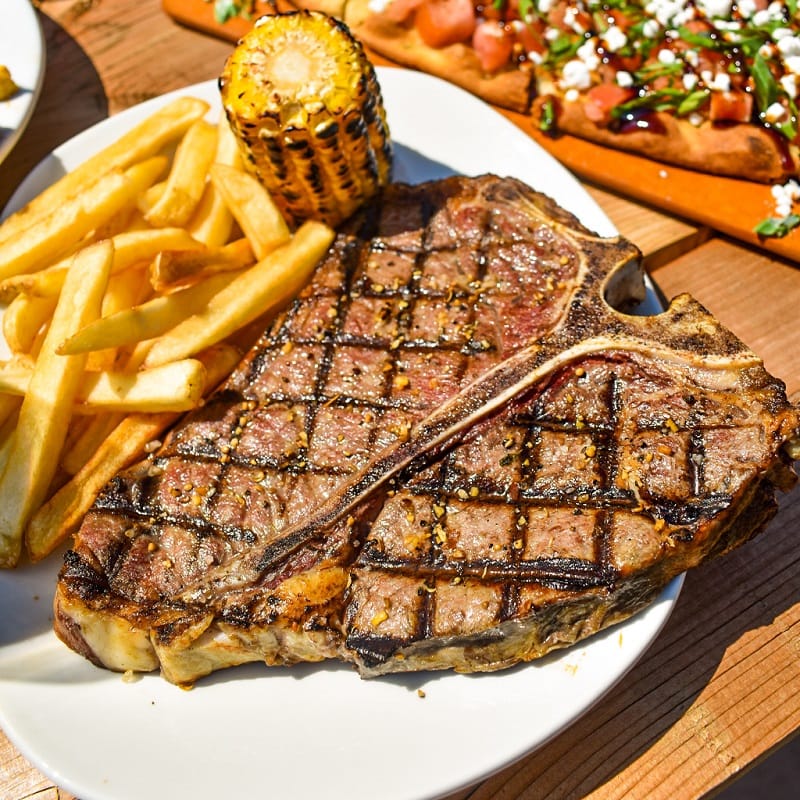
Porterhouse is a cut of steak that is well known for its size and flavor. It is often referred to as the king of steaks for a good reason. This cut of meat comes from the rear end of the short loin and includes both the tenderloin and the strip steak. It is a favorite among steak lovers and is often served in high-end restaurants. The Porterhouse steak is similar to the T-bone steak but is thicker and contains a larger portion of the tenderloin. It is typically cut to be around 1 1/4 to 1 3/4 inches thick and can weigh up to 48 ounces. This makes it an excellent cut for sharing with friends or family.
One of the reasons that the Porterhouse is so popular is that it offers the best of both worlds when it comes to steak. The tenderloin provides a melt-in-your-mouth texture, while the strip steak offers a more robust flavor. This combination creates a truly unique and delicious eating experience.
What Are The Similarities Between T Bone And Porterhouse Steaks?
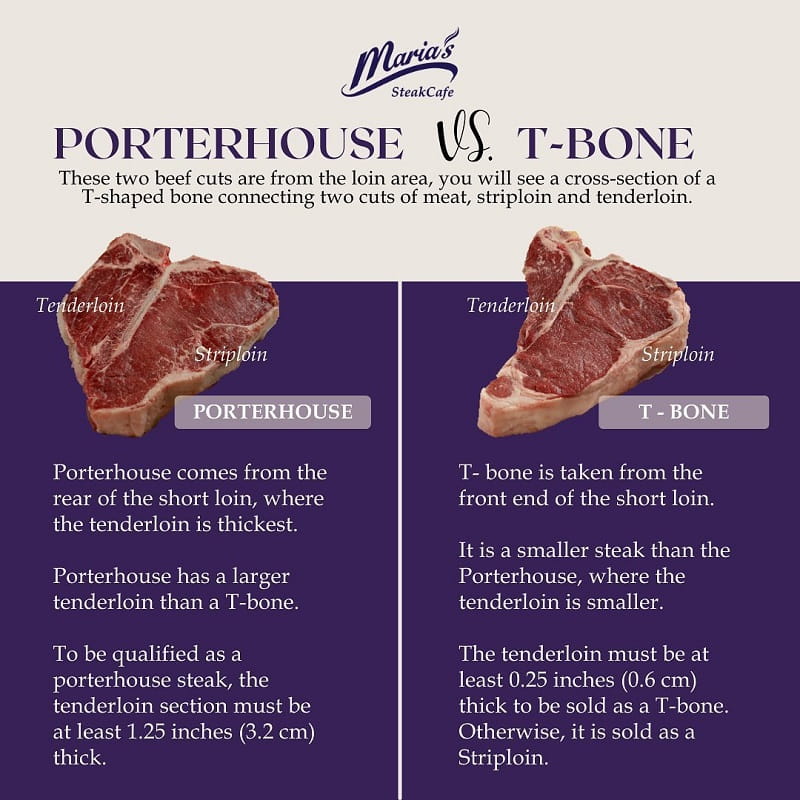
Firstly, let’s take a look at the location of the cuts. Both T bone and Porterhouse steaks are cut from the short loin of the cow. The short loin is a muscle located near the spine, known for being tender and flavorful. This means both cuts are of high quality and have a similar texture.
Another similarity is the T-shaped bone that is present in both cuts. The T-bone steak comes from the T-shaped bone separating the tenderloin and the strip steak. On the other hand, the Porterhouse steak has a larger tenderloin portion and a smaller strip steak portion. However, the T-shaped bone is still present in the Porterhouse steak, just the T bone.
Both T bone and Porterhouse steaks are also typically cooked in the same way. They are both thick cuts of meat, requiring a longer cooking time to ensure they are cooked evenly. Most people prefer to grill or broil these steaks to get a nice sear on the outside while keeping the inside juicy and tender.
Lastly, T bone and Porterhouse steaks are known for their rich and beefy flavor. This is because both cuts are taken from the same part of the cow, which provides a consistent flavor profile. The flavor of these steaks is also enhanced by the marbling, which is the fatinn the meat. The marbling in T bone and Porterhouse steaks is similar, which gives them a similar taste.
What Are The Differences Between T Bone vs Porterhouse Steaks?
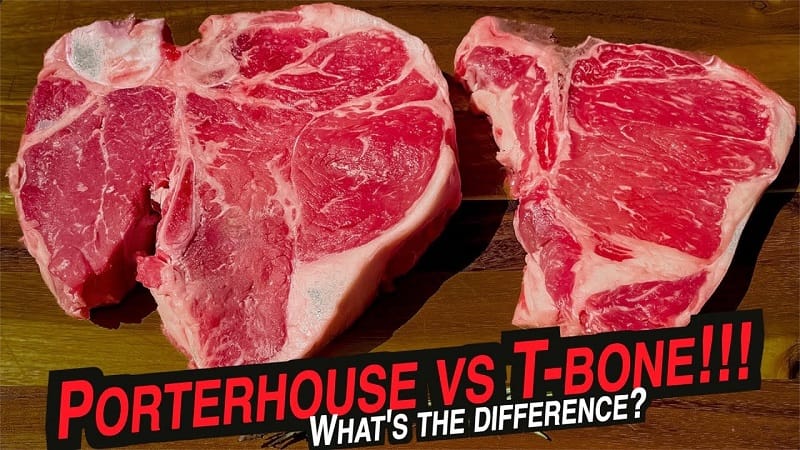
The main difference is where T-bone and Porterhouse steaks come from on the cow. T-bones are cut from the front of the short loin, whereas Porterhouse steaks are cut from the back. As a result, Porterhouse steak carries more tenderloin meat than T-bone steak, giving it a larger portion of the filet. While both steaks have a T-shaped bone, the porterhouse has a larger strip steak.
While both are delicious, some key differences set them apart. We’ll explore those differences and help you decide which cut is right for you.
Location
The T-bone and Porterhouse steaks come from the same part of the cow – the short loin. However, they are cut differently. The T-bone steak is cut closer to the front of the short loin, while the Porterhouse is cut towards the back. This means that the Porterhouse has a larger tenderloin section than the T-bone. In fact, a Porterhouse must have at least 1.25 inches of tenderloin to be considered a true Porterhouse.
Marbling
Marbling refers to the fat that is distributed within the meat. The more marbling a steak has, the more tender and flavorful it will be. T-bone and Porterhouse steaks are known for their marbling but generally have more. This is because it has a larger section of tenderloin, which is naturally more marbled than the strip steak side of the T-bone.
Fat Content
Fat content is an important factor to consider when choosing a steak. Too much fat can make the meat greasy and unappetizing, while too little can leave it dry and tough. The T-bone and Porterhouse steaks have a good amount of fat, but the Porterhouse has slightly more. This is because it has a larger section of tenderloin, which is naturally fattier than the strip steak side of the T-bone.
Texture
The texture is another important factor to consider when choosing a steak. The T-bone and Porterhouse steaks have slightly different textures due to their different cuts. The T-bone has a smaller tenderloin section, making it slightly tougher than the Porterhouse. However, the T-bone is still a very tender cut of meat, especially when cooked correctly. On the other hand, the Porterhouse is generally considered the most tender beef cut.
Is One Cut More Tender Than The Other?
When it comes to tenderness, both T-bone and Porterhouse steaks are considered to be among the most tender cuts of beef. However, the tenderness of a steak depends on several factors, including the quality of the meat, the way it’s cooked, and the thickness of the cut. Generally speaking, Porterhouse steaks tend to be thicker and larger than T-bone steaks, which may require a longer cooking time. This can sometimes result in a slightly less tender steak if it’s overcooked or undercooked.
Flavor
Regarding flavor, both cuts of beef are known for their rich, beefy taste. However, the flavor of a T-bone steak may be slightly different from that of a Porterhouse steak. The T-bone steak is cut from the short loin section of the cow, which means it has a slightly more delicate flavor and texture than the Porterhouse. On the other hand, the Porterhouse steak is cut from a section of the cow that contains both the tenderloin and the strip steak, which means it has a more robust flavor and a firmer texture.
T Bone vs Porterhouse: Popularity
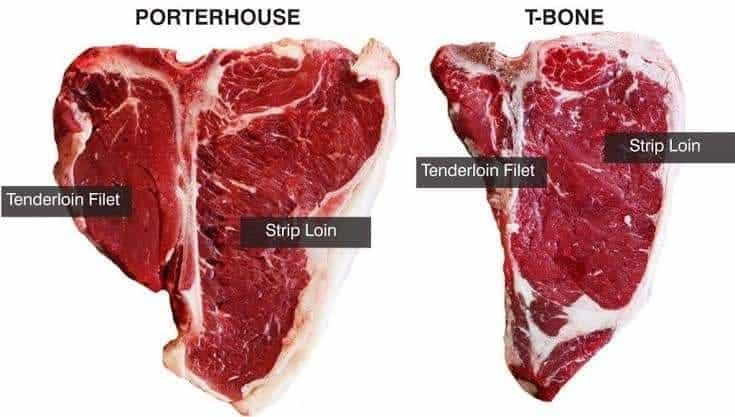
T-bone and Porterhouse steaks are incredibly popular, but the Porterhouse is often considered the ultimate steak experience. This is partly because the Porterhouse contains both the tenderloin and strip steak, two of the most desirable cuts of beef. However, T-bone steaks are also very popular, particularly among those who prefer a slightly milder flavor and a more delicate texture.
How Does The Size Of A Porterhouse Steak Compare To A T-Bone?
One of the main differences between T-bone and Porterhouse steaks is the size of the cut. T-bone steaks are generally smaller and thinner than Porterhouse steaks, which makes them an excellent option for those who want a quick and easy meal. On the other hand, Porterhouse steaks are larger and thicker, which means they can take longer to cook. However, many steak lovers believe that the larger size of the Porterhouse steak contributes to its superior flavor and texture.
Which Cut Has A Larger Portion Of Filet Meat?
Finally, if you’re a fan of filet mignon, you may be wondering which cut of steak contains more filet meat. The answer is the Porterhouse steak. The Porterhouse contains a larger portion of the tenderloin, which is the cow’s most tender and flavorful part. This means the Porterhouse steak is often considered the ultimate steak experience for those who love filet mignon.
Cooking Time
Cooking time is an essential factor when it comes to preparing steak. T-bone and Porterhouse steaks have a similar cooking time, but the thickness of the cut can impact the cooking time. Thicker cuts will require more time to cook than thinner ones.
Cooking Method
T-Bone and Porterhouse steaks are best cooked using dry-heat cooking methods, such as grilling, broiling, or pan-searing. These methods help sear the steak’s outside, creating a delicious crust while keeping the inside tender and juicy. Some people prefer to cook their steaks using a reverse-sear method, which involves cooking the steak at a low temperature in the oven before searing it on the stovetop or grill. This method can help to ensure that the steak is evenly cooked throughout.
Is T-Bone Healthier Than Porterhouse
T-bone and Porterhouse steaks are equally healthy if prepared using proper cooking techniques. The fat content in both cuts is relatively similar, but Porterhouse is slightly fattier than T-bone. However, the nutritional value also depends on the diet and lifestyle of the animal before it is harvested.
Cost
T-bone and Porterhouse steaks are both premium cuts of beef, and their prices are higher than other cuts. However, Porterhouse steak is generally more expensive than T-bone because it includes a more significant portion of the tenderloin.
Which Cut Of Steak Is More Popular Among Professional Chefs?
Professional chefs use T-bone and Porterhouse steaks, depending on the dish they are preparing. However, Porterhouse steaks are more commonly used in high-end restaurants due to their larger size and impressive presentation.
So, if you’re looking for a steak with a bigger filet, go for the Porterhouse. But the T-bone is the way to go if you prefer a steak with a smaller filet and more strip steak. Either way, you can’t go wrong with a juicy, flavorful steak cooked to perfection.
Read more:
What Is The Perfect Temperature To Cook T Bone And Porterhouse Steaks?
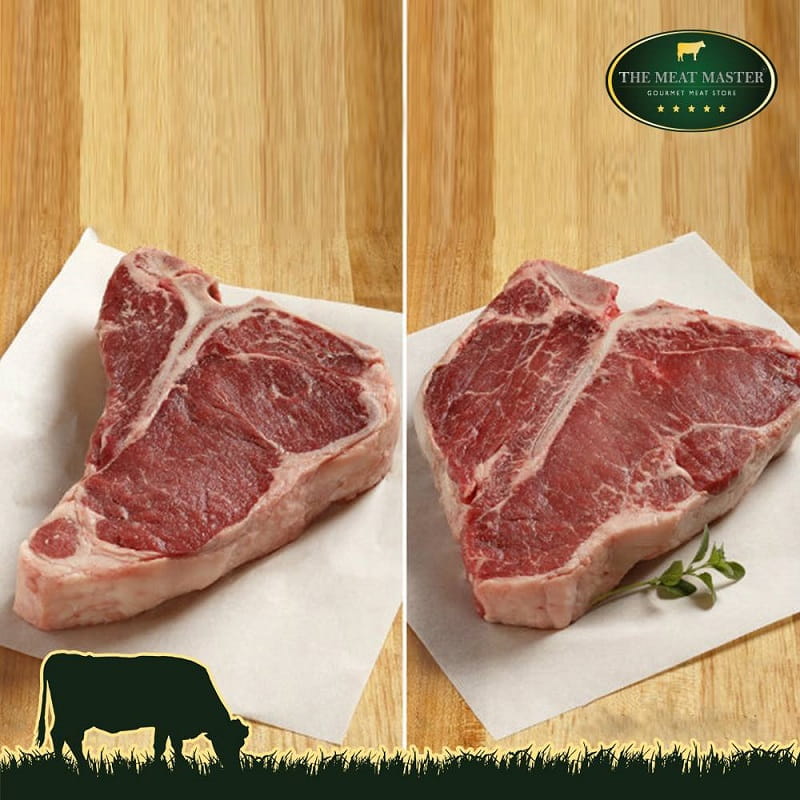
When it comes to cooking these steaks, the perfect temperature is crucial. Cooking at too high a temperature will result in a dry, tough steak while cooking at too low a temperature will result in a raw or undercooked steak. The ideal temperature for cooking T-bone and Porterhouse steaks is 130-135 degrees Fahrenheit for medium-rare, 135-145 degrees Fahrenheit for medium, and 145-155 degrees Fahrenheit for medium-well.
To achieve these temperatures, it’s important to use a meat thermometer. Insert the thermometer into the thickest part of the steak, ensuring it doesn’t touch the bone. Cook the steak on a preheated grill or in a cast-iron skillet over medium-high heat until it reaches your desired temperature. Let the steak rest for a few minutes before slicing and serving.
Common Mistakes To Avoid When Cooking T Bone And Porterhouse Steaks
If you’re new to cooking T-bone and porterhouse steaks, you should avoid some common mistakes to achieve the perfect steak. We’ll discuss some of these mistakes and provide tips on how to avoid them.
Mistake #1: Not Taking the Meat Out of the Fridge Early Enough
One of the biggest mistakes people make when cooking T-bone and porterhouse steaks are not letting the meat come to room temperature before cooking. This can result in uneven cooking, with the outside of the steak overcooked while the center is still raw. To avoid this, take the steak out of the fridge at least 30 minutes before cooking, and let it sit at room temperature. This will allow the meat to cook more evenly and prevent tough, chewy steaks.
Mistake #2: Not Seasoning the Steak Properly
Another mistake people make when cooking T-bone and porterhouse steaks are not seasoning the meat properly. Salt and pepper are essential for bringing out the steak’s natural flavors, but many people season the meat too early or too late. Season the steak with salt and pepper just before cooking to avoid this mistake. This will help the seasoning penetrate the meat evenly, resulting in a delicious, flavorful steak.
Mistake #3: Overcooking the Steak
Overcooking T-bone and porterhouse steaks is a common mistake that can ruin the texture and flavor of the meat. These steaks are best-cooked medium-rare to medium, which means they should have a warm, pink center. To avoid overcooking the steak, use a meat thermometer to check the temperature of the meat. For medium-rare, the internal temperature should be around 130-135°F, while medium should be around 140-145°F.
Mistake #4: Not Letting the Steak Rest
After cooking T-bone and porterhouse steaks, many people make the mistake of cutting into the meat too soon. This can cause the juices to run out, resulting in a dry, tough steak. Let the steak rest for at least 5-10 minutes to avoid this mistake before cutting into it. This will allow the juices to redistribute throughout the meat, resulting in a tender, juicy steak.
Mistake #5: Using the Wrong Cooking Method
Finally, using the wrong cooking method can also result in a less-than-perfect T-bone or porterhouse steak. These steaks are best cooked using dry heat methods such as grilling, broiling, or pan-searing. Avoid moist cooking methods like boiling or steaming, as these can result in tough, chewy meat.
Sides, Sauces, And Beverages Pair Well With T-Bone And Porterhouse Steak
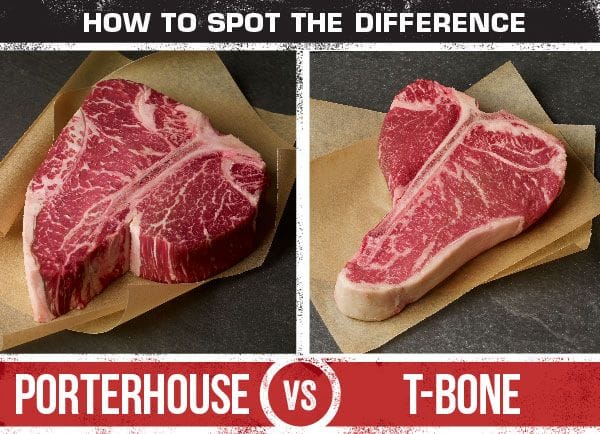
Have you ever wondered what sides, sauces, and beverages pair well with your T-Bone And Porterhouse Steak? Nơ, we’ll explore some of the best accompaniments that perfectly complement T-bone and Porterhouse steaks. Sides
Sides
When it comes to the sides, the key is to find options that balance out the richness of the steak while adding some texture and freshness to the plate. Here are some of our top picks:
- Grilled Vegetables: Grilled vegetables such as asparagus, zucchini, and bell peppers are a great way to add color and flavor to your plate. The smoky char and sweetness of the vegetables complement the steak’s savory flavors, creating a well-rounded plate.
- Creamed Spinach: Creamed spinach is a perfect choice if you’re looking for something more indulgent. The rich and creamy texture of the spinach pairs well with the juicy steak, creating a decadent flavor profile.
- Roasted Potatoes: Roasted potatoes are a classic steakhouse side that never gets old. The potatoes’ crispy exterior and fluffy interior provide a satisfying contrast to the tender steak.
Sauces
A good sauce can make or break a steak dish. Here are some of the sauces that pair well with T-bone and Porterhouse steaks:
- Béarnaise Sauce: Béarnaise sauce is a classic French sauce made with butter, egg yolks, vinegar, shallots, and tarragon. The tangy and herbaceous flavors of the sauce perfectly complement the rich flavors of the steak.
- Chimichurri Sauce: Chimichurri sauce is a vibrant and zesty sauce made with parsley, garlic, oregano, red pepper flakes, vinegar, and oil. The bright flavors of the sauce cut through the richness of the steak, making it a perfect match.
- Red Wine Sauce: A red wine sauce is a classic choice for a steak dinner. The bold and robust flavors of the sauce pair well with the meaty flavors of the steak, creating a decadent and satisfying dish.
Beverages
The right beverage can elevate your steak dining experience to new heights. Here are some of the best beverages to pair with T-bone and Porterhouse steaks:
- Red Wine: Red wine is the classic choice for a steak dinner, and for a good reason. The tannins and acidity of the wine cut through the richness of the steak, creating a balanced and enjoyable dining experience.
- Stout Beer: Stout beer is a great choice for those who prefer something more robust and full-bodied. The beer’s malty and caramel flavors complement the steak’s meaty flavors, making it a perfect match.
- Whiskey: For those who prefer something stronger, whiskey is a great choice. The smoky and woody flavors of the whiskey pair well with the charred flavors of the steak, creating a complex and delicious pairing.
Tips For Grilling The Perfect T-Bone And Porterhouse Steaks
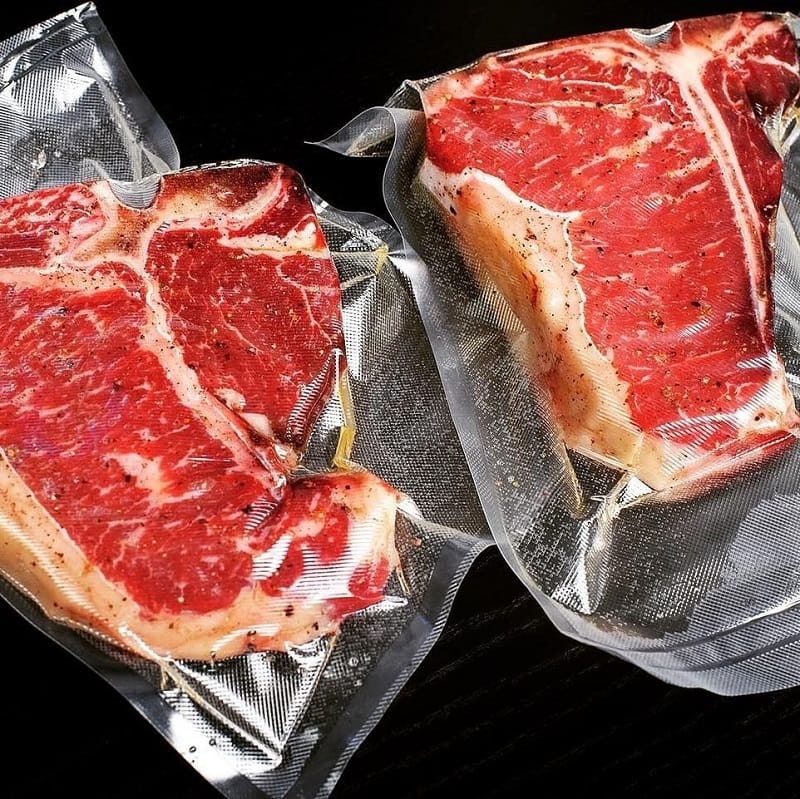
Grilling a T-bone or Porterhouse steak can be daunting, but it doesn’t have to be. With the right tools and techniques, you can grill the perfect steak every time. Here are some tips to help you grill the perfect T-bone or Porterhouse steak.
- Start with a good cut of meat: The quality of the meat you choose is crucial to grilling the perfect steak. Look for T-bone or Porterhouse steaks that are well-marbled with fat. The fat will help keep the steak juicy and add flavor. Also, make sure the steak is at room temperature before grilling.
- Season the steak: Season the steak with salt and pepper generously. You can also add a rub or marinade if you want extra flavors. Make sure you season both sides of the steak.
- Preheat the grill: Preheat the grill to high heat. You want the grill to be hot to get a good sear on the steak.
- Sear the steak: Place the steak on the grill and sear for 2-3 minutes on each side. You want the steak to have a nice crust on the outside.
- Lower the heat and cook the steak: After searing the steak, lower the heat to medium and continue cooking until it reaches your desired doneness. Use a meat thermometer to check the temperature of the steak. For a medium-rare steak, the temperature should be 130-135°F. For a medium steak, the temperature should be 135-145°F. For a well-done steak, the temperature should be 155°F or higher.
- Let the steak rest: After cooking it, remove it from the grill and rest for 5-10 minutes before slicing. This will allow the juices to redistribute throughout the meat, making it more tender.
- Slice and serve: Slice the steak against the grain and serve it with your favorite sides.
How to Cook T Bone?
Are you craving a perfectly cooked T-Bone steak but don’t want to fire up the grill? Don’t worry. You can still achieve that mouth-watering sear and juicy interior by cooking it on the stove. Here’s how to cook pan-seared T-Bone steak on the stove like a pro.
To ensure your steak is cooked to perfection, you must ensure it’s completely thawed before cooking. We recommend thawing your steak in the refrigerator for 24 hours. This slow and steady thawing method will ensure the steak retains its texture and flavor.
You might be tempted to cook your steak straight out of the freezer, but that’s a mistake. When you cook a frozen steak, the heat from the cooking process will only penetrate the outer layer of the steak, leaving the inside raw and cold. This can not only ruin the taste of your steak but also make it unsafe to eat.
- First, preheat a heavy non-stick skillet or cast iron skillet over medium heat until it’s hot, for about 5 minutes. A hot pan is crucial to delivering the best T-Bone steak sear.
- Once the skillet is hot, place your steaks in the skillet. It’s important not to add oil or water and not to cover the steak, as this will protect the flavor.
- For a perfectly cooked medium-rare T-Bone steak, sear it in the skillet for 13-15 minutes for a 1-inch steak and 15-17 minutes for a 1½-inch steak, turning about 1 minute before the halfway point. You can use a meat thermometer to check your steak’s internal temperature, which should read 130°F.
- Once your steak is cooked to perfection, it’s essential to rest for 5 minutes before serving, covering it lightly with foil. This is because the temperature of the meat will continue to rise for as much as 5°F during this time. Resting is essential as it will give the juices time to sink back in and throughout the meat, keeping it moist and flavorful.
- Finally, use a meat thermometer to check the internal temperature of your T-Bone steak to ensure it’s cooked to your desired level of doneness, from rare to medium-well.
How to Cook Porterhouse Steaks?
Are you a fan of a good steak? Do you want to impress your friends and family with your cooking skills? Here, we will teach you how to cook a delicious Porterhouse steak in the oven.
- Preheat your oven to 250 degrees Fahrenheit. While the oven is heating up, brush your porterhouse steaks with olive oil, and sprinkle a little salt and pepper on both sides. Make sure you rub in the seasoning so that it sticks to the steak.
- Transfer the steaks to a cast-iron skillet with a drizzle of olive oil. Place the skillet in the oven and cook for about 20-30 minutes, or until the steak’s internal temperature reaches 120 degrees Fahrenheit. You can use a meat thermometer to check the temperature.
- Once the steak has reached the desired temperature, turn your stove burner to medium-high heat. Take the skillet out of the oven and sear the steak on each side for 1-2 minutes until a golden-brown crust forms. This will give your steak that delicious flavor and texture we all love.
- After searing your steak, transfer it to a clean plate and tent it with foil. Let the steak rest for 5-10 minutes. This allows the juices to redistribute and the steak to become even more tender.
FAQs
Can You Tell The Difference Between A T-Bone And A Porterhouse Just By Looking At Them?
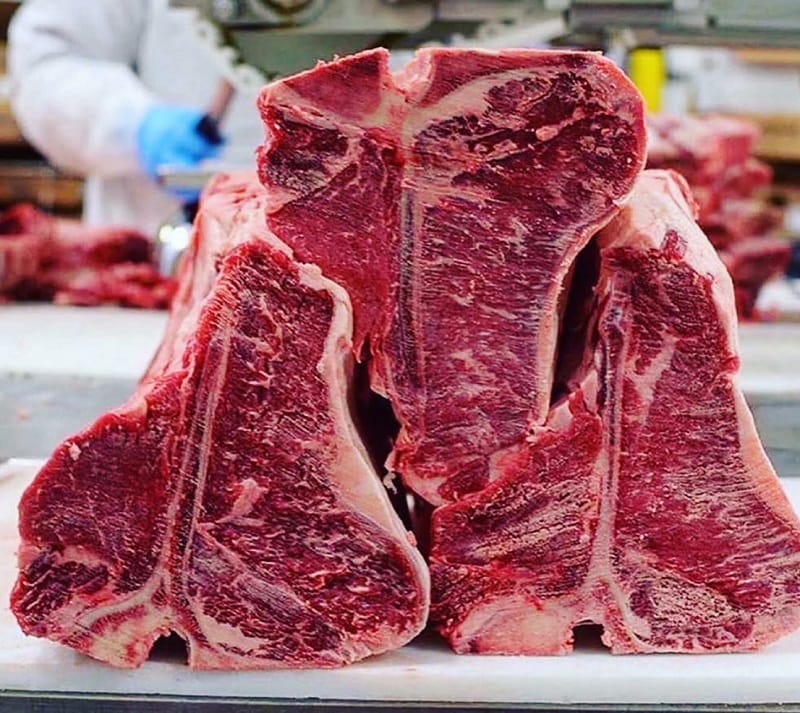
On factual, it is possible Difference Between A T-Bone And Porterhouse Just By Looking At Them to distinguish the two cuts apart. The main difference is the size of the filet portion of the steak. A Porterhouse has a significantly larger filet portion compared to a T-bone, which is cut closer to the front of the short loin. The bone in a Porterhouse is also shaped like a “T,” and on one side, it has a larger portion of the tenderloin. This means that Porterhouse steaks are bigger than T-bones and contain more calories, fats, and other nutrients. However, the calories and macros are relatively similar between the two.
Why Do Some People Consider Porterhouse To Be The King Of Steaks?
The Porterhouse steak has gained a reputation as the “king of steaks” among many food enthusiasts. This hefty steak cut comes from the short loin and includes two cuts of meat – the tenderloin and the strip steak – separated by a T-bone. The tenderloin is typically known for its tender, buttery texture, while the strip steak is known for its rich, beefy flavor. Combining these two cuts into one steak creates a unique dining experience for meat lovers.
Additionally, the Porterhouse is often associated with upscale steakhouses and fine dining, adding to its luxurious appeal. While some may argue that other cuts of meat deserve the title of “king of steaks,” the Porterhouse’s size, a combination of two different cuts, and association with high-end dining make it a top contender.
Conclusion
In conclusion, regarding T bone vs Porterhouse, it all comes down to personal preference. If you’re looking for a larger cut with a higher percentage of tenderloin, then the Porterhouse is the way to go. However, the T-bone is a great option if you prefer a smaller cut with a more balanced strip steak and tenderloin ratio.
Whether you choose a T-bone or Porterhouse steak, you’re in for a delicious and satisfying meal. The key is to select a high-quality cut of meat and cook it to perfection. So fire up the grill, grab your tongs, and get ready to enjoy some of the best steaks you’ve ever had.
References:

Hey readers! Chip Holland here, and I’m a Manager of this website. My passion for writing about it only matches my passion for BBQ. Follow my blog for mouth-watering recipes, tips, and tricks for the perfect smoke, grill, and BBQ. I’m sure you won’t be disappointed!
